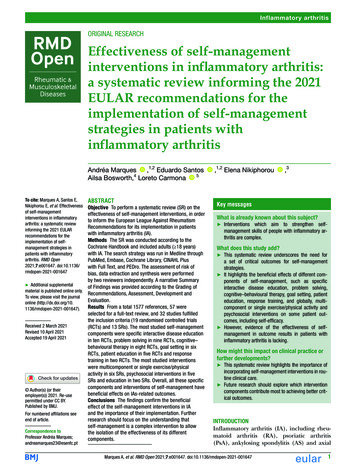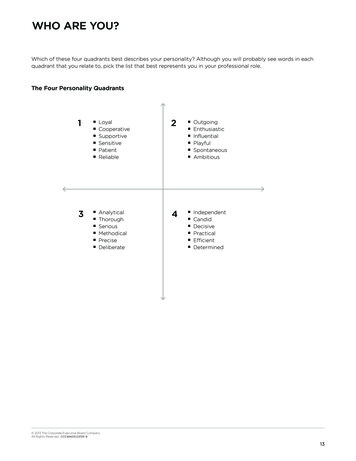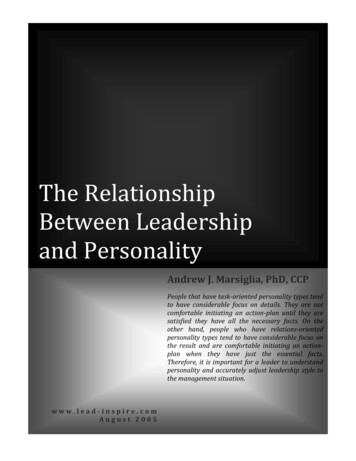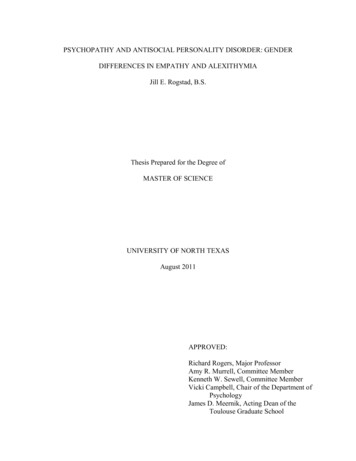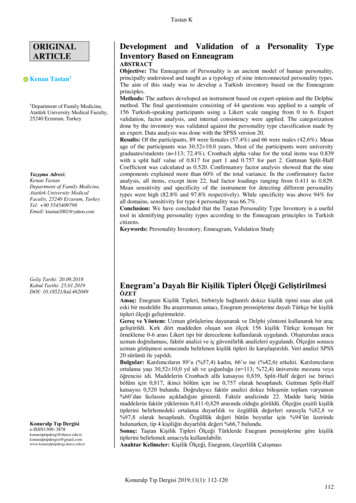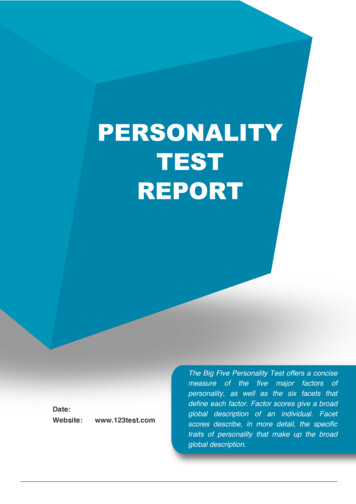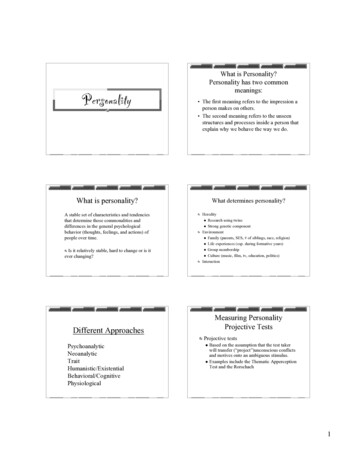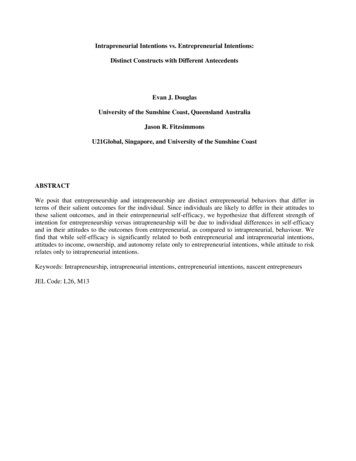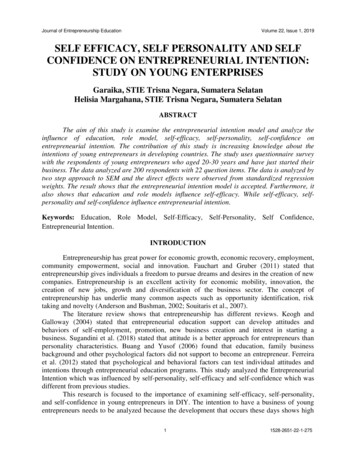
Transcription
Journal of Entrepreneurship EducationVolume 22, Issue 1, 2019SELF EFFICACY, SELF PERSONALITY AND SELFCONFIDENCE ON ENTREPRENEURIAL INTENTION:STUDY ON YOUNG ENTERPRISESGaraika, STIE Trisna Negara, Sumatera SelatanHelisia Margahana, STIE Trisna Negara, Sumatera SelatanABSTRACTThe aim of this study is examine the entrepreneurial intention model and analyze theinfluence of education, role model, self-efficacy, self-personality, self-confidence onentrepreneurial intention. The contribution of this study is increasing knowledge about theintentions of young entrepreneurs in developing countries. The study uses questionnaire surveywith the respondents of young entrepreneurs who aged 20-30 years and have just started theirbusiness. The data analyzed are 200 respondents with 22 question items. The data is analyzed bytwo step approach to SEM and the direct effects were observed from standardized regressionweights. The result shows that the entrepreneurial intention model is accepted. Furthermore, italso shows that education and role models influence self-efficacy. While self-efficacy, selfpersonality and self-confidence influence entrepreneurial intention.Keywords: Education, Role Model, Self-Efficacy, Self-Personality, Self Confidence,Entrepreneurial Intention.INTRODUCTIONEntrepreneurship has great power for economic growth, economic recovery, employment,community empowerment, social and innovation. Fauchart and Gruber (2011) stated thatentrepreneurship gives individuals a freedom to pursue dreams and desires in the creation of newcompanies. Entrepreneurship is an excellent activity for economic mobility, innovation, thecreation of new jobs, growth and diversification of the business sector. The concept ofentrepreneurship has underlie many common aspects such as opportunity identification, risktaking and novelty (Anderson and Bushman, 2002; Souitaris et al., 2007).The literature review shows that entrepreneurship has different reviews. Keogh andGalloway (2004) stated that entrepreneurial education support can develop attitudes andbehaviors of self-employment, promotion, new business creation and interest in starting abusiness. Sugandini et al. (2018) stated that attitude is a better approach for entrepreneurs thanpersonality characteristics. Buang and Yusof (2006) found that education, family businessbackground and other psychological factors did not support to become an entrepreneur. Ferreiraet al. (2012) stated that psychological and behavioral factors can test individual attitudes andintentions through entrepreneurial education programs. This study analyzed the EntrepreneurialIntention which was influenced by self-personality, self-efficacy and self-confidence which wasdifferent from previous studies.This research is focused to the importance of examining self-efficacy, self-personality,and self-confidence in young entrepreneurs in DIY. The intention to have a business of youngentrepreneurs needs to be analyzed because the development that occurs these days shows high11528-2651-22-1-275
Journal of Entrepreneurship EducationVolume 22, Issue 1, 2019enthusiasm and motivation to have a business t-wirausaha-sosial/4067164.html). Young people have a very high potential to move thebusiness in their environment tensisebagai-penggerak-wirausaha-sosial.html). The Cooperative and MSMEs Services in DIYProvince is very supportive by giving literation guidance and training for 600-1.000 MSMEs.Unfortunately, this strong intention is faced with many obstacles, such as there is no role modelthat can be adopted and the education of the entrepreneurs. They also have a relatively low -umkm-muda-lebih-sadar-akan-manajemenyangbaik). Therefore, this research is conducted to fill the research gap by relating the importance ofrole model and education of young entrepreneurs in DIY Province that will have an impact onself-efficacy, self-esteem, and self-personality that will influence the entrepreneurial intention ofyoung entrepreneurs in DIY Province.The contribution that is expected to be generated by this research is:1.Previous study shows that attitude becomes the main predictor in explaining entrepreneurial intention. Thisstudy does not use attitude as one of the factors that affect entrepreneurial intention. Entrepreneurialintention in this study is affected by other internal factors that exist in individuals, namely self-efficacy,self-personality and self-confidence. So the results make generalizations of findings that explain thatentrepreneurial intention models can be influenced by factors other than attitude and2.Miranda et al. (2017); Vohora et al. (2014) stated that the length of entrepreneur education cannot predictthe emergence of entrepreneurial intention, even Landry et al. (2006) and Stephan et al. (2007) stated thaton the relationship between the length of education and the intention to become entrepreneurs are stillconflicting. This study seeks to show that there is a relationship between education and entrepreneurialintentions, although in this study the influence of education on intention through mediation of efficacy. It ishoped that the results of this study strengthen prior study findings which state that education has aninfluence on one's entrepreneurial intention.LITERATURE REVIEWChowdhury et al. (2014) defined entrepreneurial passion as a strong and active positiveemotion to spend time and energy in entrepreneurial activities through self-identification. Kop(2012) stated that entrepreneurship as a concentrated process of several unique resources tocreate new values. Cardon et al. (2013) argued that entrepreneurship is the transfer of resources,from low output productivity to high output and productivity. Hartmann and Herb (2015) foundthat motivation passion and success have been considered as important components ofentrepreneurship. Passion is the core of entrepreneurship because it can increase creativity inadopting new information models, discovering and developing entrepreneurial opportunities(Ruvio et al., 2010). Rieckhoff & Larsen (2012) considered entrepreneurship as a passion whichallows entrepreneurs to believe that what they do is the key to fulfill dreams and overcomedifficulties.Understanding the factors associated with entrepreneurial intention allows thedevelopment of ways to reduce the gap between interest and action. Entrepreneurial Intention isdifferent from entrepreneurial interest. Entrepreneurial interest is someone's attractiveness tobecome a business owner which is likely to develop into entrepreneurial intention. Boyd andVozikis (1994) proposed entrepreneurial intention model to understand entrepreneurial intentionbased on Social Cognitive Career Theory (SCCT) from Lent and Savickas (1994). ThisEntrepreneurial intention model has many similarities with the SCCT model which highlightsbeliefs and self-efficacy on the intention to shape one's career choices.21528-2651-22-1-275
Journal of Entrepreneurship EducationVolume 22, Issue 1, 2019Education and Self-EfficacyVohora et al. (2004) stated that entrepreneurs who get the education they needed canidentify new opportunities for commercial applications. The greater the experience, the greaterthe probability of detecting the right opportunities for the exploitation of the spin-off creationLandry et al. (2006). Stephan et al. (2007) found the long relationship between academic servicesand entrepreneurial intentions are not conclusive; while another study found that the length oflearning has significant decreased effect on entrepreneurial ability in recent years (Bercovitz andFeldman, 2008). The research result from Handaru et al. (2013) also proved that business ownerthat are male, from non-Chinese race, and experienced a formal education has a difference ofentrepreneurial self-efficacy rather than the one who does not experienced a formal education.H1: Education associates with self-efficacy.Role Model and Self-EfficacyRole model is an individual who provides an example of success that can be reached bysomeone, and provides the behavioral template that is required to achieve the success(Morgenroth, 2015). Bandura (1997) stated that self-efficacy refers to an individual’s believe inhis ability to do something. The influence of role model toward self-efficacy is explained byDouglas & Shepherd, (2002); Krueger et al. (2000) who stated that role model is important inshaping self-efficacy, and will ultimately determine someone’s career aspiration. Role model hasa high influence because it provides opportunities to social model and social persuasion(Bandura, 2000). A positive experience of a subordinate and a mentor, who has a career that is inline with the interests of his subordinate, can enable subordinates to learn, practice, and buildconfidence in carrying out the skills that will be needed for their career choice (Auken et al.,2006) so that it will increase its self-efficacy. Role model can influence entrepreneurial intentionif they can change their attitude and self-efficacy about the ability that a person feels to become asuccessful business owner (Auken et al., 2006; Fellnhofer, 2017).Role model has a meaningfulrelationship toward someone’s self-efficacy, because role model can give information aboutcareer aspiration, direction of strategic coping in coping frustration (Auken et al., 2006), andprovide road map for youth while looking for their career direction. Role model increase selfefficacy through giving effect to actions and feelings in the decision making process.H2: Role model associates with self-efficacy.Self-Efficacy and Entrepreneurial IntentionSelf-efficacy is defined as a person's belief in his ability to perform a task (Gist, 1987),and one's belief that he can effectively use this skill to achieve certain results (Bandura, 1997).Zhao et al. (2005) stated that self-efficacy affects someone entrepreneurship. Self-efficacyinfluences Entrepreneurial Intention through cognitive processes, motivation and throughemotional states. A person who has high self-efficacy shows greater intellectual ability, strategicflexibility, and effectiveness in managing the environment (Bandura, 1997). In other words,these people exercised more control because they tried to plan the best and worst scenario andare able to adapt with changes in plans and manage environmental fluctuations. People with highlevels of self-efficacy can anticipate obstacles that might hinder achieving their goals (Bandura,31528-2651-22-1-275
Journal of Entrepreneurship EducationVolume 22, Issue 1, 20192000). Baidi and Suyatno (2018); Travis and Freeman (2018) added that self-efficacy has apositive influence toward entrepreneurial intention.H3: Self-efficacy associates with entrepreneurial intention.Self-Personality and Entrepreneurial IntentionSome psychological characteristics have been proposed to influence EntrepreneurialIntention, namely need-for-achievement, risk-taking tendency, tolerance for ambiguity, locus ofcontrol and goal setting (Fini et al., 2009). The self-personality concept refers to socialpsychology theory and social interaction. Entrepreneurial personality has different personalitycompetencies and requirements. Entrepreneurial personality is an individual's ability to managesocial networks and diversity, identify opportunities, mobilize resources and implement businessideas (Luca, 2017). Chan et al. (2015) stated that the need for achievement, innovative spirit,proactive, self-efficacy, stresstolerance, internal autonomy, locus of control, risk tendency, andambiguitytolerance can predict entrepreneurial intention. Travis and Freeman (2018) added thatthe proactive personality of someone can increase entrepreneurial IntentionH4: Self-personality associates with entrepreneurial intention.Self-Confidence and Entrepreneurial IntentionAnderson et al. (2009) and Athayde (2009) stated that entrepreneurial attitudes predictentrepreneurial intentions that lead to individual behavior. Ho and Koh (1992) argued that selfconfidence is a required entrepreneurship characteristic and self-confidence is related to otherpsychological characteristics. Empirical study in the entrepreneurial literature has found thatentrepreneurs have higher self-confidence than non-entrepreneurs (Ferreira et al., 2012).H5: Self-confidence associates with entrepreneurial intention.RESEARCH METHODSThis study uses survey with respondents of young entrepreneurs who were motivated tobecome entrepreneurs. These respondents are most appropriate in predicting entrepreneurialintentions. Researchers use primary data with questionnaires through in-depth interviews so thedata is accurate and reliable. The questionnaire consists of 22 items adopted from Evans (2010);Miranda et al. (2017) and Luca (2017). Respondent's answer refers to a 6-point Likert scalestarting from strongly agree to strongly disagree. The population in this study is all youngentrepreneurs who have started their businesses both startup and conventional businesses. Thesampling technique is non-random sampling, namely purposive sampling. Respondents aged are20-30 years and they already had their own business. The number of respondents is 200respondents. Researchers immediately distributed questionnaires face to face and explained it torespondents so that the data isn’t bias and unanswered questionnaires could be resolved. Dataanalysis techniques use a two-step approach to Structural Equation Modeling (SEM) with theAMOS (Analysis of Moment Structure) program. Testing of models developed with Goodness ofFit criterias, namely Chi-square, probality, RMSEA, GFI, and TLI (Hair et al., 1998).SEM is used in this research because it has some advantages such as (Hair et al., 1998):1.The ability to create model from other construct.2.Make the whole model test possible.41528-2651-22-1-275
Journal of Entrepreneurship Education3.Volume 22, Issue 1, 2019Using confirmatory factor analysis to reduce measurement error thathas many indicators in one latentvariable.The direct influence (path coefficient) is seen from standardized regression weight, bytesting the comparative significance of the CR (Critical Ratio) value that is similar with the tcount. From the result of AMOS program, the causal relationship between variables will be seenthroughly by looking at the direct influence. The significance assessment is based on theprobability (p) value, the significance limit that is used is p value 0.05. The test toward thedeveloped model is done by Goodness of Fit criteria, which is Chi-Square, probability, RMSEA,GFI, and TLI (Hair et al., 1998). This research uses self-efficacy, self-personality, and selfconfidence because related to this research topic, the internal aspect of individual shows animportant influence in explaining someone’s tendency to have a business. According to Luca(2017), Rauch & Frese (2007); Chan et al. (2015), the internal aspect of individual that is strongenough explains entrepreneurial behavior as self-efficacy, self-personality, and self-confidence.The understanding of internal aspect of individual provides information to evaluate a decisionand give an integrative view about behavior that cannot be controlled by other people(Steenkamp & Gielens, 2003).RESULTCharacteristics of Respondents DescriptionData regarding the characteristics of respondents can be seen in Table 1. Description ofthe majority of respondents in this study were female is 53%, Diploma & Bachelor is 45%, asmanager is 67%, long time 5 years is 76% and fashion business is 45%.Table 1RESPONDENT CHARACTERISTICDemographyBusiness TenureMale47% 5 years76%Female53% 5 years24%EducationType of BusinessSenior High School44%Start-up13%Diploma, Bachelor45%Fashion45%Others11%Culinary27%Travel agent10%Other5%JobStudent235%Manager67%Government employees10%Validity and Reliability Test ResultsThis study uses data which collected from 200 young entrepreneurs in Yogyakarta. Datawere obtained by using instruments equipped with in depth Interview. The confirmatory factoranalysis results show that the six constructs, namely: education, role model, self-efficacy, selfpersonality, self-confidence and entrepreneurial Intention which consist of 22 questions havegood validity. Standardized loadings factor value 0.3. The value of construct reliability is51528-2651-22-1-275
Journal of Entrepreneurship EducationVolume 22, Issue 1, 2019above 0.7 and variance extracted recommended is 0.50 (Hair et al., 1998), so all instrumentsare reliable.The validity test of this research is construct validity. Construct validity is consist of twotypes of test, which is convergent and discriminant validity. Convergent validity shows thevalues obtained from the question that measure the same concept that has the high correlation,while discriminant validity shows the values obtained from the items that measure differentconstruct that do not correlate with each other. The measurement of convergent validity isconducted by looking at all loading from a talent construct to the corresponding indicators thathave a value of CR 2 and the lambda value (standardized factor loading) that is required isgreater than 0.4. If this condition is not achieved, then the critical ratio value or CR that isidentical to the t-count that is greater than 2 also indicate that the indicator is significantly thedimension of the factors formed (Hair et al., 1998). The test result construct validity can be seenon Table 2 as follows.Table 2TEST RESULT OF CONSTRUCT VALIDITYValidityIndicatorFactor loadingInformationEducation 10.789ValidEducation 20.789ValidEducation 30.807ValidEducation 40.547ValidRole model 10.841ValidRole model 20.572ValidRole model 30.771ValidSelf-efficacy 10.616ValidSelf-efficacy 20.756ValidSelf-efficacy 30.689ValidSelf-efficacy 40.68ValidSelf-personality 10.742ValidSelf-personality 20.661ValidSelf-personality 30.589ValidSelf-personality 40.667ValidSelf-confidence 10.732ValidSelf-confidence 20.826ValidSelf-confidence 30.585ValidSelf-confidence 40.803ValidEntrepreneur Intention 10.81ValidEntrepreneur Intention 20.802ValidEntrepreneur Intention 30.791ValidBased on Table 1, it can be seen that all of the questionnaire items are valid since all of ithas a greater factor loading than 0.5 (Hair et al., 1998). The reliability test is done by examining61528-2651-22-1-275
Journal of Entrepreneurship EducationVolume 22, Issue 1, 2019internal consistency, construct reliability, and variance extracted. The reliability test can be seenon Table 3.ConstructEducationTable 3RELIABILITY TEST RESULTNumberKoefisienConstructof ItemCronbach formationReliableRole Model30.7590.9470.859ReliableSelf Efficacy40.7240.9490.825ReliableSelf Confidence40.7210.9780.918ReliableSelf Personality40.7340.9690.889ReliableEntrepreneur intention30.7210.9680.91ReliableThe limit value that is used to assess an acceptable level of reliability is 0.70 (Hair et al.,1998). Variance extracted shows the number of indicators variance that is extracted by developedlatent construct. The high value of variance extracted shows that the indicators have wellrepresented the developed latent construct. The recommended variance extracted value is at least0.50. The test of reliability of internal consistence for each construct using the Cronbach’s Alphacoefficient have met the required rules of thumb which is 0.7 (Hair et al., 1998). Anotherreliability test that is conducted is construct reliability test and variance extracted. Constructreliability and extracted variance show a consistent instrument, which is indicated by the value ofconstruct reliability above 0.7 and variance extracted 0.50. Both tests are still in the corridor ofinternal consistency test that will give researchers greater confidence that individual indicatorsmeasure a similar measurement (Hair et al., 1998).Results of Revisit Intention Model Testing Using SEM.The results of testing the two step approach model to SEM entrepreneurial intentionusing AMOS 21 can be seen in Figure 1 and the evaluation of the model testing results can beseen in Table 4.Table 4EVALUATION OF THE GOODNESS OF FIT INDICES CRITERIACriteriaResultCritical Value (*)Model EvaluationCmin/DFProbabilityRMSEA4.3290.8540.0121 Cmin/DF 5.00 . . GoodGoodGoodGFI0.954 . GoodTLI0.945 . GoodCFI0.982 . Sources: (*) Hair et al., (1998).Good71528-2651-22-1-275
Journal of Entrepreneurship EducationVolume 22, Issue 1, 2019FIGURE 1ENTREPRENEURIAL INTENTION MODELFrom Table 4 it can be stated that the model can be accepted. To test the hypothesis ofcausal relationship between education, role model, self-efficacy, self-personality, self-confidenceand entrepreneurial intention presented in path coefficients that show a causal relationshipbetween these variables. The relationship is shown in Table 5.Table 5PATH COEFFICIENT (STANDARDIZE REGRESSION) INTER VARIABLESPathPath CoefficientCRProbability (p)DescriptionEducation self-efficacy0.3565.5020.00SupportedRole model self-efficacy0.2533.9140.00SupportedSelf-efficacy Entrepreneurial Intention0.1392.1380.033SupportedSelf-personality Entrepreneurial Intention0.4757.1870.00SupportedSelf-confidence Entrepreneurial Intention0.1362.2340.025SupportedHypothesis testing is conducted by comparing the probability value (p) which issignificant if the p value is 0.05. With the criteria, all paths are significant. Education has asignificant positive effect on self-efficacy of 35.6%. Role model has a significant positive effecton self-efficacy of 25.3%. Self-efficacy has a positive effect on entrepreneurial intention of13.95%. Self-personality has a positive effect on Entrepreneurial Intention 47.5%. Selfconfidence has a positive effect on Entrepreneurial Intention of 13.6%.DISCUSSIONThe result of this study indicates that the structural entrepreneurial intention model is fit.It means that this model can be explained by education, role model, self-efficacy, self81528-2651-22-1-275
Journal of Entrepreneurship EducationVolume 22, Issue 1, 2019personality, self-confidence. The research result proves that education has a positive significantinfluence toward self-efficacy (H1 is accepted). It means that this supports the research findingsfrom Vohora et al. (2004); Landry et al. (2006); Stephan et al. (2007).The previous researchresult shows that entrepreneurs who get an education can identify new opportunity forcommercial application. Handaru et al. (2013) also added that someone who has a formaleducation will have a different self-efficacy with someone who does not have a formaleducation.The research result proves that role model has a positive significant influence towardself-efficacy (H2 is accepted). This research result supports the research findings fromMorgenroth (2015); Douglas & Shepherd, (2002); Krueger et al. (2000) who stated that rolemodel is important to form someone’s belief for decision making to be success (self-efficacy).Role model gives a picture of actual positive experience of someone in choosing their career andmakes it possible for someone to learn, train, and build their self-esteem (Auken et al., 2006).Role model can increase self-efficacy through a picture of a career path, strategic direction, andinfluence of decision making (Auken et al., 2006).The research result proves that self-efficacy has a positive significant influence towardEntrepreneurial Intention. (H3 is accepted).This research result supports the research findingsfrom Zhao et al. (2005); and Wilson et al. (2007), which stated that self-efficacy has an influencetoward the form of entrepreneurial intention, which means that young entrepreneurs who haveconfidence in completing tasks, has intellectual levels, and strong motivation will have a highself-efficacy, where self-efficacy can influence the intention of entrepreneurship. Self-efficacy isable to increase entrepreneurial intention through individual cognitive and emotional processes(Morgenroth, 2015).The research result proves that self-personality has a positive significant influence towardEntrepreneurial Intention. (H4 is accepted). This research result supports the research result fromFini et al., 2009); Luca (2017); Rauch & Frese (2007); Chan et al. (2015) which stated that selfpersonality has an influence toward entrepreneurial intention. Chan et al. (2015) shows thatindividual who have a good personality will have a higher self-esteem to be entrepreneur. Selfpersonality that include needs for achievement, ability to face risks and good locus of control,creativity, innovative, proactive, stress tolerance, internal autonomy, influence entrepreneurintention.The research result proves that self-confidence has a positive significant influence towardEntrepreneurial Intention. (H5 is accepted). This research result supports the research result fromAnderson et al. (2009); Athayde (2009); Ferreira et al. (2012); Sugandini et al. (2018), whichstated that self-confidence has an influence toward entrepreneurial intention. Young entrepreneurwho has a high self-confidence will be easier to make decision to build their own business,because he is sure that he has an ability to adapt with his environment, utilize the technologyinnovation, and anticipate any risks that might arise. This research result also supports Ferreira etal. (2012) who stated that entrepreneur has a higher self-confidence than non-entrepreneur.CONCLUSIONThis research has a conclusion such as:1.Education has a positive significant influence toward self-efficacy.2.Role model has a positive significant influence toward self-efficacy.3.Self-efficacy has a positive significant influence toward Entrepreneurial Intention.91528-2651-22-1-275
Journal of Entrepreneurship EducationVolume 22, Issue 1, 20194.Self-personality has a positive significant influence toward Entrepreneurial Intention.5.Self-confidence has a positive significant influence toward Entrepreneurial Intention.LIMITATION AND FUTURE RESEARCH ORIENTATIONThe limitation of this research and the future research orientation are as follows:1.First, this research only analyzes self-efficacy, self-personality, and self-confidence as the antecedent ofentrepreneurial intention. The research result shows that self-efficacy and self-confidence is not strongenough to predict entrepreneurial intention. Future research is expected to deepen the study of the influenceof self-efficacy and self-personality in predicting entrepreneurial intention. Therefore, it can reinforce theinfluence of these two variables.2.Second, variable related to attitude toward new technology is also considered in predicting entrepreneurialintention (Sugandini et al., 2018a). According to Chen (2014), besides self-efficacy, risk propensity andpersonal innovativeness with information technology also can be considered in predicting entrepreneurialintention. Besides that, according to Chowdhury et al. (2014), entrepreneurial passion also can be anantecedent of entrepreneurial intention.3.This research only take the setting of young entrepreneur who have run a business, for future research it issuggested to use Multi Trait-Multi Method (MTMM), with the respondents of college student (who havenot owned a business), young entrepreneurs, and successful entrepreneurs, in order to get morecomprehensive understanding in predicting entrepreneurial behavior. The analysis method that can be usedis survey and quasi experiment. The analysis tool that can be used is different test to distinguish thebehavior of each type of respondent, regression to observe the influence between variables, and structuralequation modeling to test the overall model of entrepreneurial behavior.REFERENCESAnderson, A., Dodd, S., & Jack, S. (2009). Aggressors; winners; victims and outsiders: European school’s socialconstruction of the entrepreneur. International Small Business Journal, 27(1), 126-136.Anderson, C.A., & Bushman, B.J. (2002). The effects of media violence on society. American Association for theAdvancement of Science, 295, 2377-2379.Athayde, R. (2009). Measuring enterprise potential in young people. Entrepreneurship: Theory and Practice, 33(2),481-500.Auken, H., Fry, F., & Stephens, P. (2006). The influence of role models on entrepreneurial intentions. Journal ofDevelopmental Entrepreneurship, 11(2), 157-167.Baidi., & Suyatno. (2018). Effect of entrepreneurship education, self efficacy and need for achievement towardstudent's entrepreneurship intention: Case study in FEBI, IAIN Surakarta, Indonesia. Journal ofEntrepreneurship Education, 21(2), 1-16.Bandura, A. (1997). Self-efficacy: Toward a unifying theory of behavioral change. Psychological Review, 84(2),191-215.Bandura, A. (2000). Self-efficacy. In Kazdin, A.E. (Ed.), Encyclopedia of psychology (pp.212-213). New York:Oxford University Press.Bercovitz, J., & Feldman, M. (2008). Academic entrepreneurs: Organizational change at the individual level.Organization Science, 19(1), 69-89.Boyd, N., & Vozikis, G. (1994). The influence of self-efficacy on the development of entrepreneurial intentions andactions. Entrepreneurship: Theory and Practice, 18(4), 63-77.Buang, N.A., & Yusof, Y.M. (2006). Motivating factors that influence class F contractors to become entrepreneurs.Journal of Education Malaysia, 31, 107-121.Cardon, M.S., Gregoire, D.A., Stevens, C.E., & Patel, P.C. (2013). Measuring entrepreneurial passion: Conceptualfoundations and scale validation. Journal of Business Venturing, 28(3), 373-396.101528-2651-22-1-275
Journal of Entrepreneurship EducationVolume 22, Issue 1, 2019Chan, K.Y., Uy, M.A., Chernyshenko, O.S., Ho, M.R., & Sam, Y. (2015). Personality and entrepreneurial,professional and leadership motivations. Personality and Individual Differences. 77, 161-166.Chen, L. (2014). Understand
Self-Confidence and Entrepreneurial Intention Anderson et al. (2009) and Athayde (2009) stated that entrepreneurial attitudes predict entrepreneurial intentions that lead to individual behavior. Ho and Koh (1992) argued that self-confidence is a required entrepreneurship characteristic and self

